AI-Driven Decision Support Systems in Agile Software Project Management: Enhancing Risk Mitigation and Resource Allocation
Abstract
1. Introduction
- To leverage AI to provide actionable insights for prioritizing tasks, optimizing sprints, and addressing potential risks before they escalate.
- To develop predictive models to identify risks early in the project lifecycle, enabling proactive interventions.
- To implement dynamic algorithms to balance workloads, resolve resource conflicts, and improve team productivity across distributed and cross-functional teams.
- To provide a holistic evaluation framework, combining data-driven metrics like velocity and burn-down rates with qualitative factors such as team morale and collaboration.
2. Related Work
3. Proposed Framework
3.1. Design Philosophy and Objectives of the Framework
3.2. Framework Architecture and Key Components
3.2.1. AI-Powered Risk Mitigation Module
- is the probability of risk occurrence (predicted using logistic regression or decision trees).
- The risk’s impact is estimated based on project parameters like budget deviation, time overrun, or resource availability.
3.2.2. Resource Optimization Engine
- is the utility derived from resource .
- is the resource allocated to task by resource .
- is the capacity of resource .
- is the total number of resources and is the total number of tasks.
3.2.3. Integration with Agile Processes
3.3. Interaction Between Risk Mitigation and Resource Allocation
3.4. Workflow of the Framework
3.5. Tools, Data Sources, and Evaluation Metrics
3.5.1. Tools
3.5.2. Data Sources
3.5.3. Evaluation Metrics
4. Results and Analysis
5. Discussion
6. Conclusions and Future Work
Funding
Data Availability Statement
Conflicts of Interest
References
- Alliance, A. Manifesto for Agile Software Development. Agile Alliance. 2001. Available online: http://www.agilealliance.org (accessed on 13 December 2024).
- Jahan, S.A. Utilizing Predictive Analytics and Machine Learning for Enhanced Project Risk Management and Resource Optimization. IPHO—J. Adv. Res. Bus. Manag. Account. 2024, 2, 24–31. [Google Scholar]
- Saklamaeva, V.; Pavlič, L. The Potential of AI-Driven Assistants in Scaled Agile Software Development. Appl. Sci. 2023, 14, 319. [Google Scholar] [CrossRef]
- Brown, G. A Critical Evaluation of the Application of Agile Software Development Methods to Distributed Development Efforts, Citeseer. Master’s Thesis, School of Computing, Napier University, Edinburgh, UK, 2007. Available online: http://citeseerx.ist.psu.edu/viewdoc/download (accessed on 13 December 2024).
- Lui, K.M.; Chan, K.C. Software Development Rhythms: Harmonizing Agile Practices for Synergy; John Wiley & Sons: Hoboken, NJ, USA, 2008. [Google Scholar]
- Galli, B.J.; Lopez, P.A.H. Risks management in agile new product development project environments: A review of literature. Sustain. Bus. Concepts Methodol. Tools Appl. 2020, 1835–1869. [Google Scholar]
- Filippetto, A.S.; Lima, R.; Barbosa, J.L.V. A risk prediction model for software project management based on similarity analysis of context histories. Inf. Softw. Technol. 2020, 131, 106497. [Google Scholar] [CrossRef]
- Rahman, M.A.U.; Roman, M.; Ahmad, S.; Jan, M.S.; Nawab, H.U. Optimizing Collaboration: Insights into Inter-Team Coordination and Self-Management in Distributed Agile Software Development. Webology 2021, 18, 4751–4769. [Google Scholar]
- Müller, K.; Koch, C.; Riehle, D.; Stops, M.; Harutyunyan, N. Challenges of Working from Home in Software Development During Covid-19 Lockdowns. ACM Trans. Softw. Eng. Methodol. 2023, 32, 1–41. [Google Scholar] [CrossRef]
- Betta, J.; Boronina, L. Transparency in project management–from traditional to agile. In Third International Conference on Economic and Business Management (FEBM 2018); Atlantis Press: Amsterdam, The Netherlands, 2018; pp. 446–449. [Google Scholar]
- Hadar, E.; Silberman, G.M. Agile architecture methodology: Long-term strategy interleaved with short-term tactics. In Proceedings of the Companion to the 23rd ACM SIGPLAN Conference on Object-Oriented Programming Systems Languages and Applications, Nashville, TN, USA, 19–23 October 2008; pp. 641–652. [Google Scholar]
- Zadeh, E.K.; Khoulenjani, A.B.; Safaei, M. Integrating AI for agile Project Management: Innovations, challenges, and benefits. Int. J. Ind. Eng. Constr. Manag. 2024, 1, 1–10. [Google Scholar]
- Bittner, K.; Spence, I. Managing Iterative Software Development Projects; Addison-Wesley Professional: Boston, MA, USA, 2006. [Google Scholar]
- Turban, E. Decision Support, and Business Intelligence Systems; Pearson Education India: Chennai, India, 2011. [Google Scholar]
- Hamid, M.; Zeshan, F.; Ahmad, A.; Ahmad, F.; Hamza, M.A.; Khan, Z.A.; Munawar, S.; Aljuaid, H. An Intelligent Recommender and Decision Support System (IRDSS) for Effective Management of Software Projects. IEEE Access 2020, 8, 140752–140766. [Google Scholar] [CrossRef]
- Uysal, M.P. Machine learning and data science project management from an agile perspective: Methods and challenges. In Contemporary Challenges for Agile Project Management; IGI Global: New York, NY, USA, 2022; pp. 73–88. [Google Scholar]
- Fatima, T. A Predictive Analytics Approach to Project Management: Reducing Project Failures in Web & Software Development Projects. In Proceedings of the International Conference on Data Science (ICDATA), 2017: The Steering Committee of The World Congress in Computer Science, Compute, Meknes, Morocco, 18–19 December 2017; pp. 10–16. [Google Scholar]
- Martins, N.C.; Marques, B.; Alves, J.; Araújo, T.; Dias, P.; Santos, B.S. Augmented reality situated visualization in decision-making. Multimed. Tools Appl. 2021, 81, 14749–14772. [Google Scholar] [CrossRef]
- Goker, N. A novel integrated intuitionistic fuzzy decision aid for agile outsourcing provider selection: A COVID-19 pandemic-based scenario analysis. Soft Comput. 2021, 25, 13723–13740. [Google Scholar] [CrossRef]
- Garaibeh, N.K. DSS Development and Agile Methods: Towards a new Framework for Software Development Methodology. Int. J. Mach. Learn. Comput. 2012, 2, 438–442. [Google Scholar] [CrossRef]
- Drury, M.; Conboy, K.; Power, K. Obstacles to decision making in Agile software development teams. J. Syst. Softw. 2012, 85, 1239–1254. [Google Scholar] [CrossRef]
- Odejide, O.A.; Edunjobi, T.E. AI in project management: Exploring theoretical models for decision-making and risk management. Eng. Sci. Technol. J. 2024, 5, 1072–1085. [Google Scholar] [CrossRef]
- Tasneem, N.; Zulzalil, H.B.; Hassan, S. Enhancing Agile Software Development: A Systematic Literature Review of Requirement Prioritization and Reprioritization Techniques. IEEE Access 2025, 13, 32993–33034. [Google Scholar] [CrossRef]
- Radwan, A.M.; Abdel-Fattah, M.A.; Mohamed, W. AI-Driven Prioritization Techniques of Requirements in Agile Methodologies: A Systematic Literature Review. Int. J. Adv. Comput. Sci. Appl. 2024, 15, 812. [Google Scholar] [CrossRef]
- Lin, J. Context-aware task allocation for a distributed agile team. In Proceedings of the2013 28th IEEE/ACM International Conference on Automated Software Engineering (ASE), Silicon Valley, CA, USA, 11–15 November 2013; IEEE: Piscataway Township, NJ, USA, 2013; pp. 758–761. [Google Scholar]
- Quintana, M.A.; Palacio, R.R.; Soto, G.B.; González-López, S. Agile Development Methodologies and Natural Language Processing: A Mapping Review. Computers 2022, 11, 179–187. [Google Scholar] [CrossRef]
- Goyal, A. Driving Continuous Improvement in Engineering Projects with AI-Enhanced Agile Testing and Machine Learning. Int. J. Adv. Res. Sci. Commun. Technol. 2023, 3, 1320–1331. [Google Scholar] [CrossRef]
- Naz, A.; Khan, A.S.; Atif, M. Agile Risk Mitigation Framework. Int. J. Comput. Sci. Netw. Secur. 2021, 21, 586–596. [Google Scholar]
- Zhou, H.; Wang, Q.; Wang, L.; Zhao, X.; Feng, G. Digitalization and third-party logistics performance: Exploring the roles of customer collaboration and government. Int. J. Phys. Distrib. Logist. Manag. 2023, 53, 467–488. [Google Scholar] [CrossRef]
- Singh, M. Agile Project Management and Testing in the Distributed Development Environment. Ph.D. Thesis, JC Bose University, Faridabad, India, 2024. [Google Scholar]
- Shrivastava, S.V.; Rathod, U. A risk management framework for distributed agile projects. Inf. Softw. Technol. 2017, 85, 1–15. [Google Scholar] [CrossRef]
- Eramo, R.; Muttillo, V.; Berardinelli, L.; Bruneliere, H.; Gomez, A.; Bagnato, A.; Sadovykh, A.; Cicchetti, A. AIDOaRt: AI-augmented Automation for DevOps, a model-based framework for continuous development in Cyber-Physical Systems. Microprocess. Microsyst. 2022, 94, 104672. [Google Scholar]
- Rehman, W.; Zainab, H.E.; Imran, J.; Bawany, N.Z. NFTs: Applications and challenges. In Proceedings of the 2021 22nd International Arab Conference on Information Technology (ACIT), Muscat, Oman, 21–23 December 2021; IEEE: Piscataway Township, NJ, USA, 2021; pp. 1–7. [Google Scholar]
- Britto, R.; Neto, P.S.; Rabelo, R.; Ayala, W.; Soares, T. A hybrid approach to solve the agile team allocation problem. In Proceedings of the 2012 IEEE Congress on Evolutionary Computation, Brisbane, Australia, 10–15 June 2012; IEEE: Piscataway Township, NJ, USA, 2012; pp. 1–8. [Google Scholar]
- Kyriklidis, C.; Dounias, G. Evolutionary computation for resource leveling optimization in project management. Integr. Comput. Eng. 2016, 23, 173–184. [Google Scholar] [CrossRef]
- Kieling, E.J.; Rodrigues, F.C.; Filippetto, A.; Barbosa, J. Smartalloc: A model based on machine learning for human resource allocation in projects. In Proceedings of the 25th Brazillian Symposium on Multimedia and the Web, Rio de Janeiro, Brazil, 29 October–1 November 2019; pp. 365–368. [Google Scholar]
- Shu, W.; Cai, K.; Xiong, N.N. Research on strong agile response task scheduling optimization enhancement with optimal resource usage in green cloud computing. Futur. Gener. Comput. Syst. 2021, 124, 12–20. [Google Scholar] [CrossRef]
- Chasanidou, D.; Elvesæter, B.; Berre, A.-J. Enabling team collaboration with task management tools. In Proceedings of the 12th International Symposium on Open Collaboration, Berlin, Germany, 17–19 August 2016; pp. 1–9. [Google Scholar]
- Dugbartey, A.N.; Kehinde, O. Optimizing project delivery through agile methodologies: Balancing speed, collaboration and stakeholder engagement. World J. Adv. Res. Rev. 2025, 25, 1237–1257. [Google Scholar] [CrossRef]
- Olszewska, M.; Heidenberg, J.; Weijola, M.; Mikkonen, K.; Porres, I. Quantitatively measuring a large-scale agile transformation. J. Syst. Softw. 2016, 117, 258–273. [Google Scholar] [CrossRef]
- Speth, S. Issue Management for Multi-Project, Multi-Team Microservice Architectures. Master’s Thesis, University of Stuttgart, Stuttgart, Germany, 2019. [Google Scholar]
- Zieglmeier, V.; Pretschner, A. Trustworthy transparency by design. arXiv 2021, arXiv:2103.10769. [Google Scholar]
- Cervone, H.F. Improving Strategic Planning by Adapting Agile Methods to the Planning Process. J. Libr. Adm. 2014, 54, 155–168. [Google Scholar] [CrossRef]
- Nguyen-Duc, A.; Cabrero-Daniel, B.; Przybylek, A.; Arora, C.; Khanna, D.; Herda, T.; Rafiq, U.; Melegati, J.; Guerra, E.; Kemell, K.-K. Generative Artificial Intelligence for Software Engineering—A Research Agenda. arXiv 2023, arXiv:2310.18648. [Google Scholar]
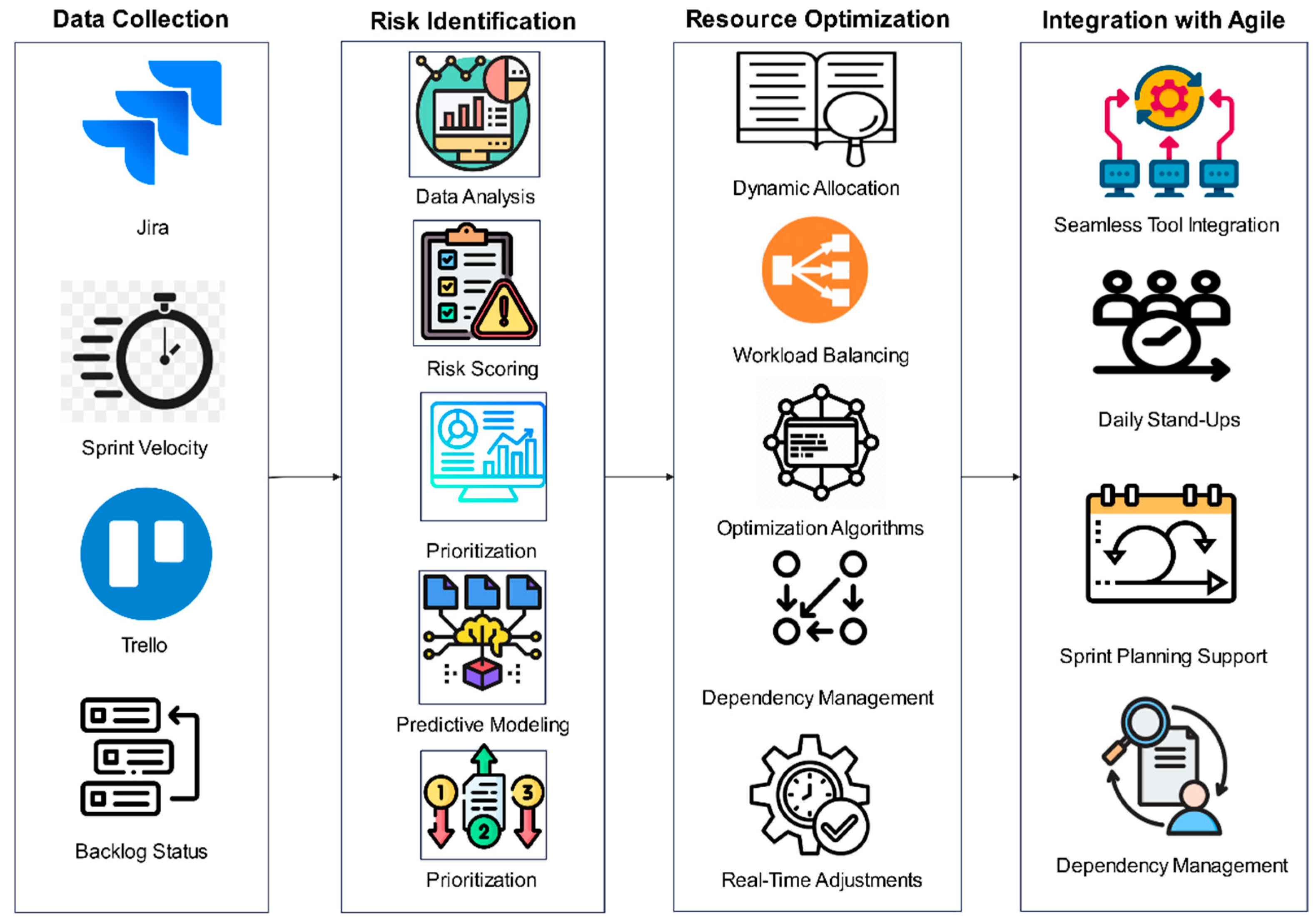
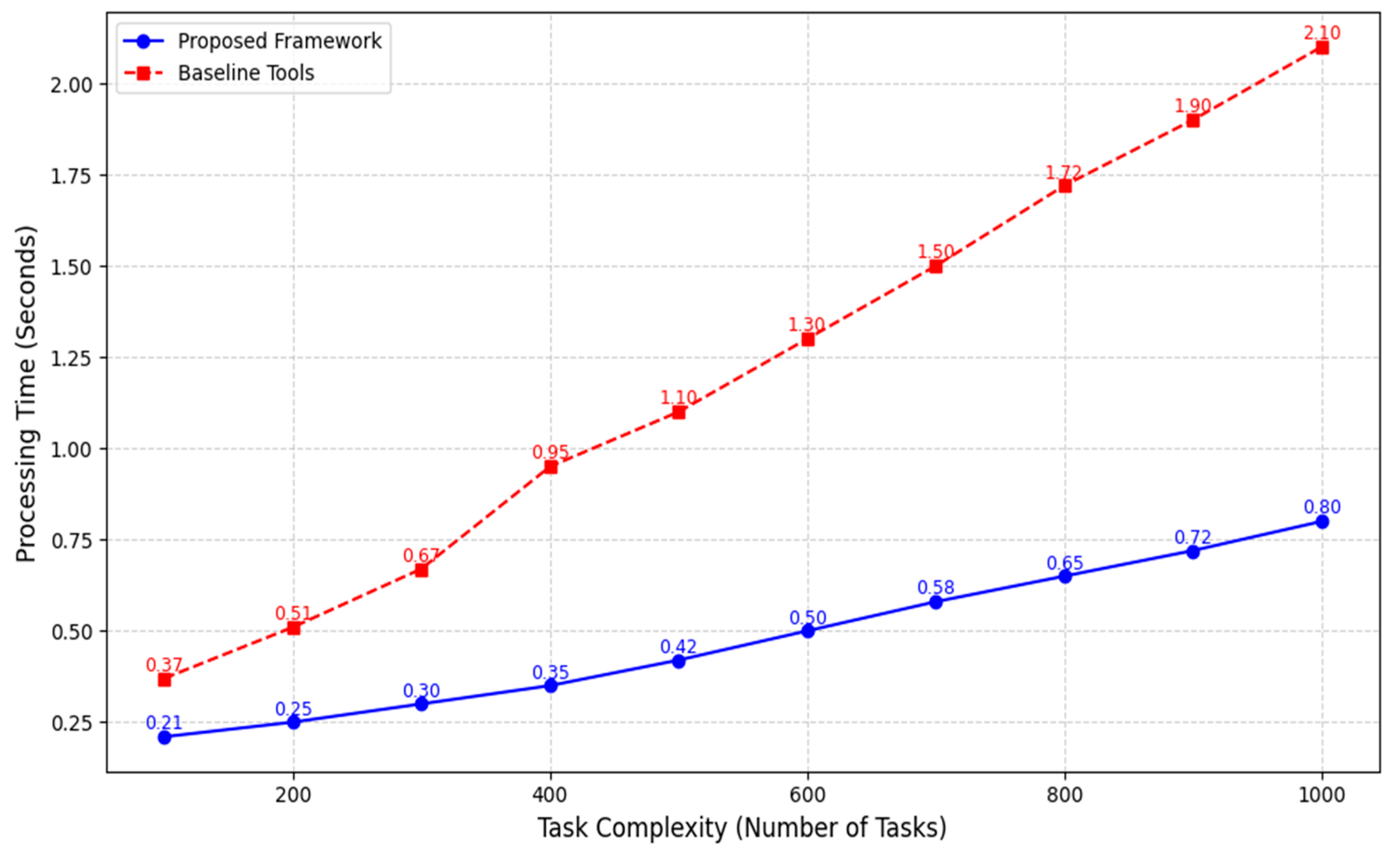


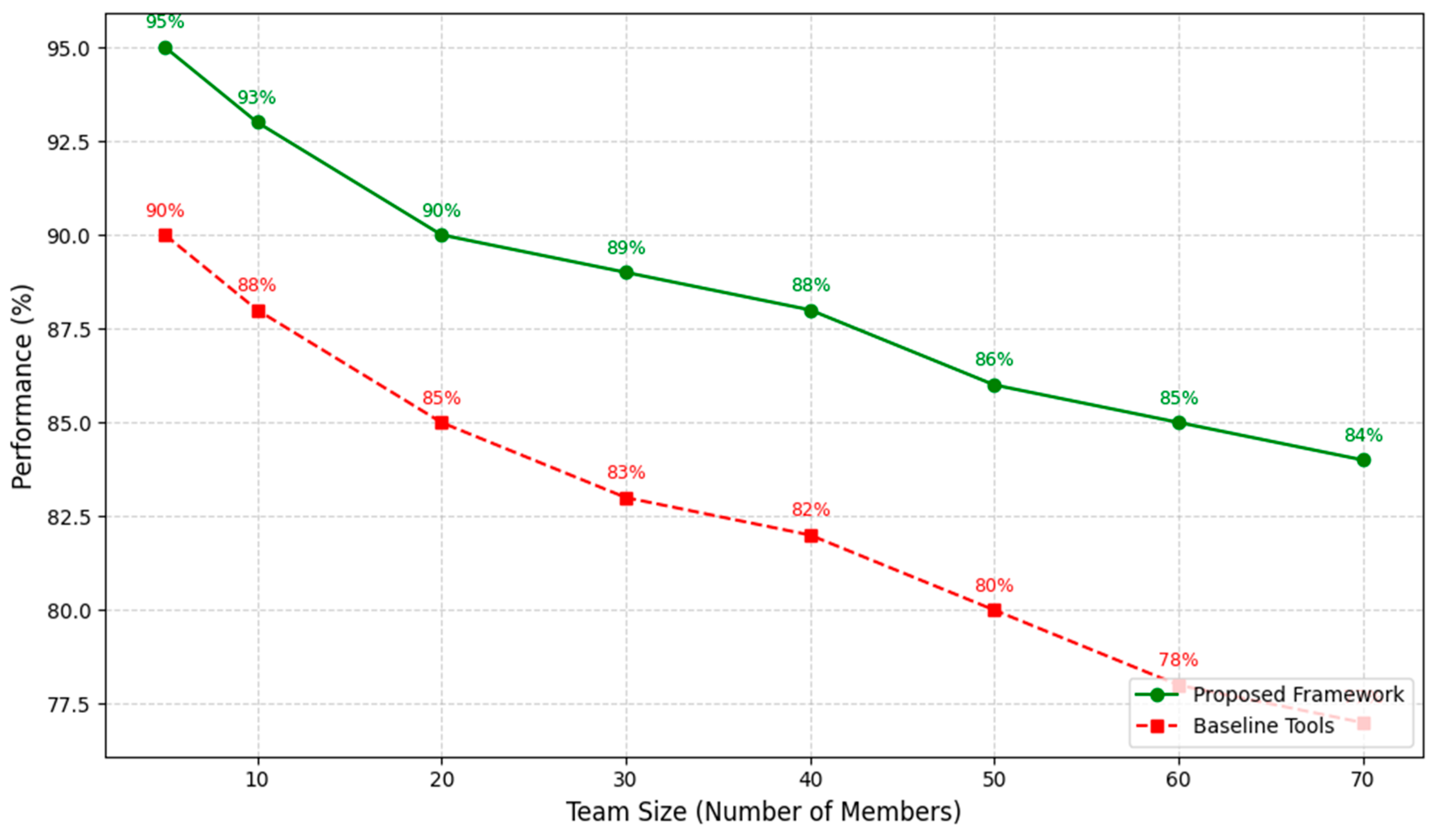
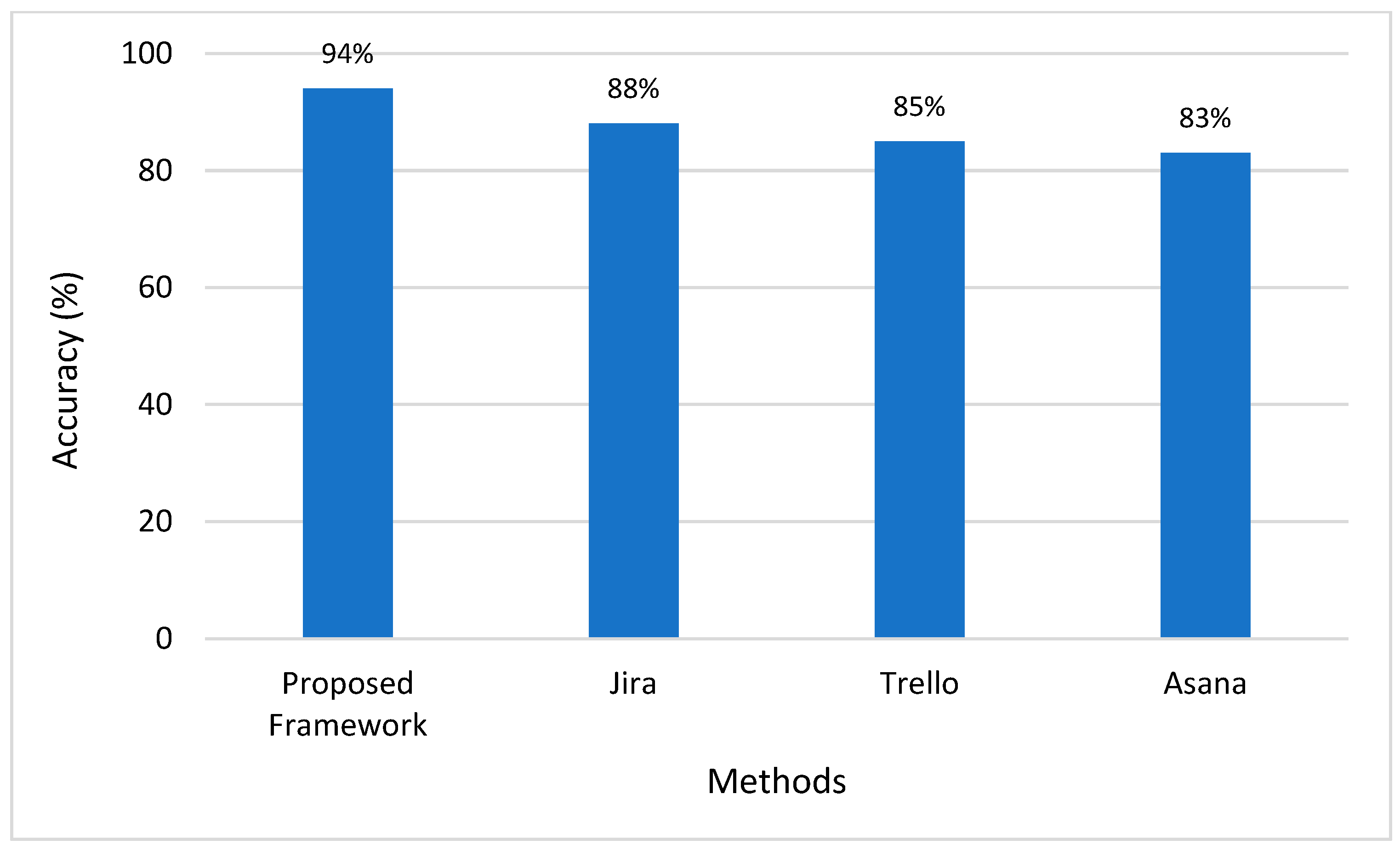
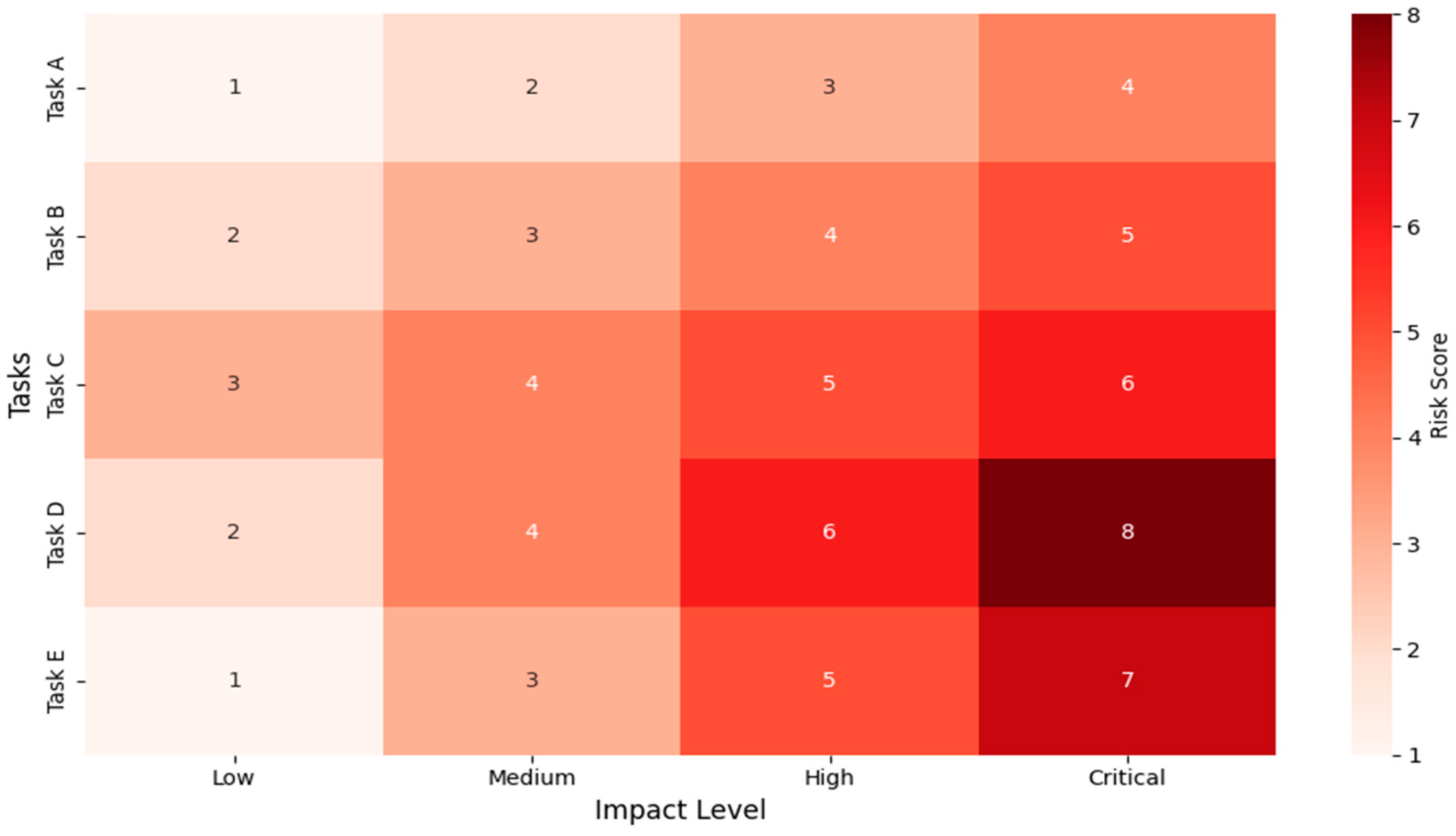


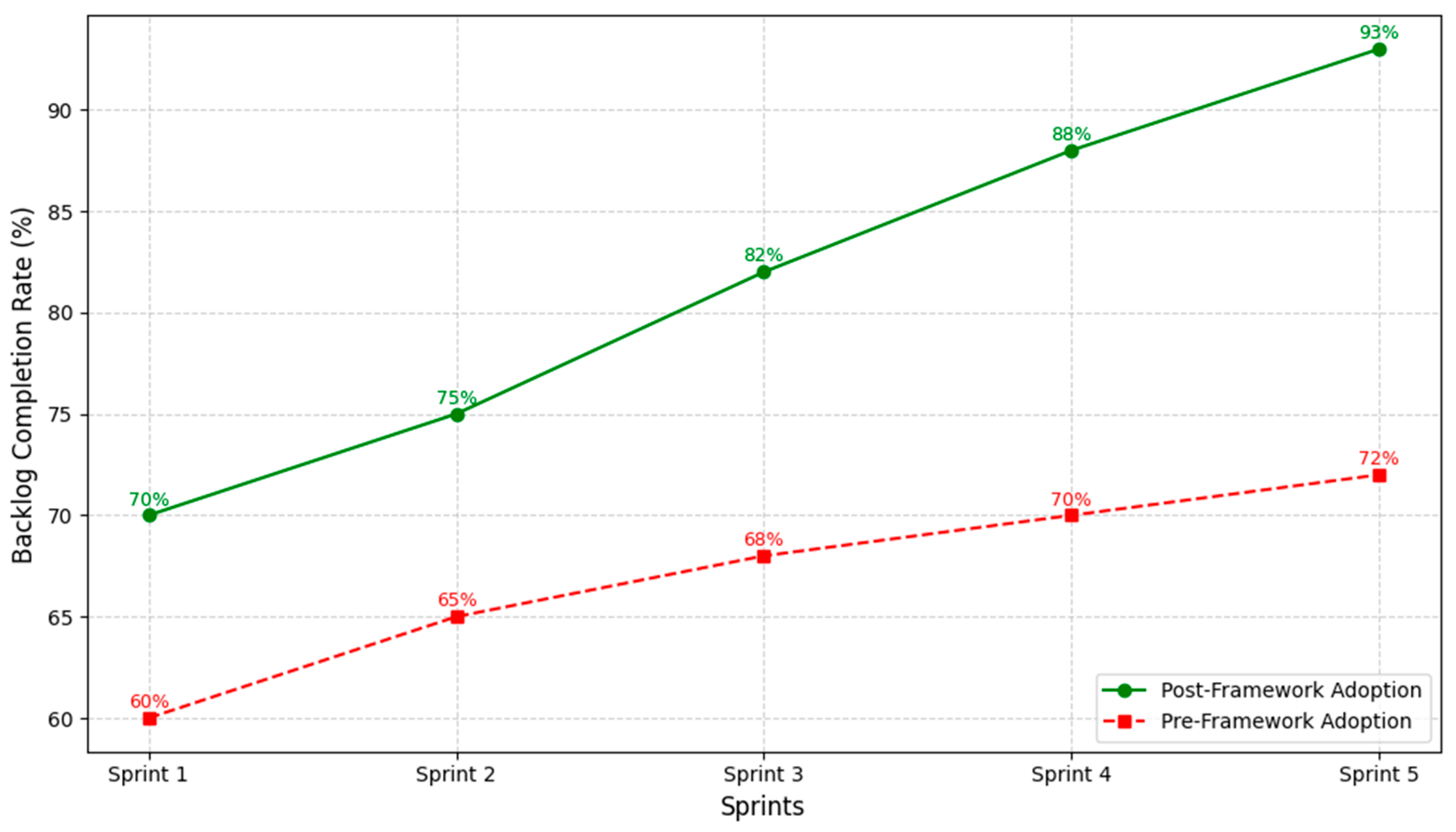
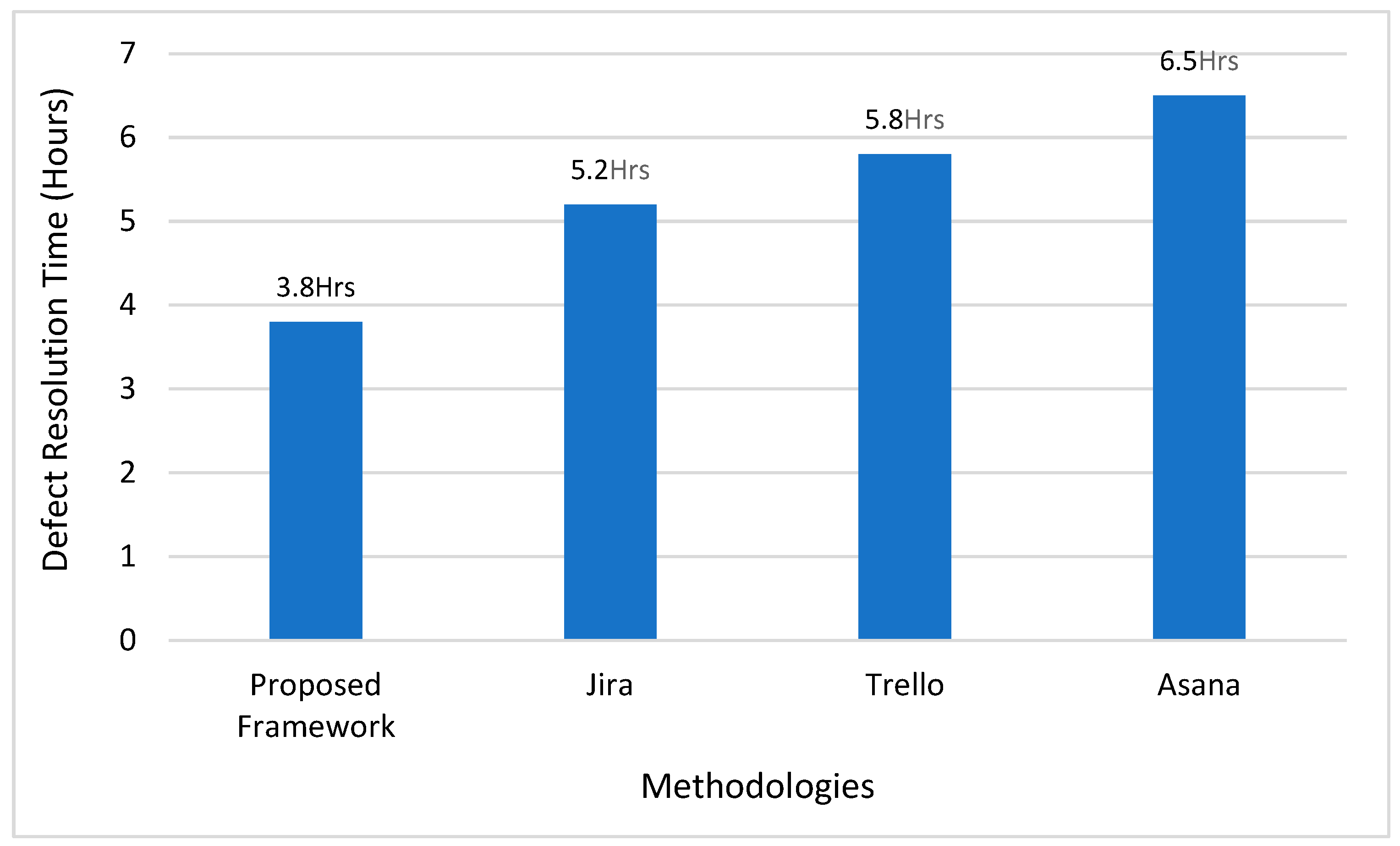

| Metric | Proposed Framework | Existing Tools |
|---|---|---|
| Precision | 0.93 | 0.81 |
| Recall | 0.91 | 0.78 |
| F1-Score | 0.92 | 0.79 |
| Dataset Size (Tasks) | Proposed Framework (s) | Existing Tools (s) |
|---|---|---|
| 100 | 0.21 | 0.37 |
| 500 | 0.25 | 0.51 |
| 1000 | 0.30 | 0.67 |
| 2000 | 0.35 | 0.95 |
| Metric | Proposed Framework | Baseline Methods |
|---|---|---|
| Workload Balance Improvement | 25% | 12% |
| Resource Idle Time Reduction | 30% | 15% |
| Task Completion Time Reduction | 18% | 10% |
| Metric | Proposed Framework | Baseline Tools |
|---|---|---|
| Risk Identification Accuracy | 94% | 81% |
| Average Resolution Time (hours) | 4.5 | 7.2 |
| False Positive Rate | 6% | 15% |
| Metric | Proposed Framework | Baseline Methods |
|---|---|---|
| Average Team Workload Balance | 92% | 78% |
| Resource Idle Time Reduction | 34% | 18% |
| Task Completion Rate Improvement | 22% | 11% |
| Metric | Proposed Framework | Existing Tools |
|---|---|---|
| Sprint Completion Rate | 96% | 83% |
| Backlog Completion Rate | 92% | 78% |
| Defect Resolution Time (hours) | 3.8 | 5.9 |
| Risk Prediction Accuracy | 94% | 81% |
| Agile Condition | Best-Performing AI Strategy | Key Performance Metrics | Impact on Agile Workflow |
|---|---|---|---|
| High Uncertainty and Frequent Changes | Risk Prediction Model (ML-based) | 94% accuracy in early risk detection | Enabled proactive mitigation, reducing sprint disruptions |
| Multi-Team Resource Sharing | Optimization-Based Resource Allocation | 25% workload balance improvement 30% idle time reduction | Prevented bottlenecks and ensured efficient task distribution |
| Time-Sensitive Agile Sprints | Real-Time Adaptive Decision-Making | 18% increase in sprint completion rate | Allowed dynamic adjustments to evolving priorities |
| Agile Environment | Scalability Considerations | Framework Adaptability Features | Expected Impact |
|---|---|---|---|
| Small Teams (≤10 members, co-located) | Low computational demand Minimal integration complexity | Lightweight AI models Local deployment support | Enhanced decision-making with minimal overhead |
| Medium-Sized Teams (10–50 members, hybrid setup) | Moderate computational load Partial resource sharing | Cloud-based deployment API integration with Agile tools | Improved resource allocation and risk mitigation |
| Large-Scale Teams (50+ members, multi-project setup) | High computational demand Cross-team dependencies | Scalable optimization algorithms Automated task prioritization | Increased efficiency in workload distribution and cross-team coordination |
| Distributed Agile Teams (Multi-location, remote collaboration) | Need for real-time data synchronization High complexity in communication | Cloud integration AI-driven task prioritization based on real-time updates | Seamless collaboration and enhanced transparency across teams |
| Category | Proposed Framework | Existing Tools |
|---|---|---|
| Usability (1–5 scale) | 4.7 | 3.9 |
| Task Prioritization Impact | 91% | 72% |
| Resource Optimization Impact | 89% | 68% |
| Methodology | Decision Support | Risk Prediction Accuracy (%) | Resource Optimization Efficiency (%) | Real-Time Adaptability | Integration with Agile Tools |
|---|---|---|---|---|---|
| Traditional DSS [14] | Rule-based models | 75 | 68 | Low | Limited |
| Machine Learning-Based Agile Risk Mitigation [7] | ML-based risk analysis | 85 | 78 | Medium | Partial |
| AI-Assisted Resource Management in Agile [44] | Neural network-based scheduling | 88 | 85 | Medium | Limited |
| Proposed Framework (AI-Driven Decision Support System) | AI-based predictive analytics | 94 | 92 | High | Seamless (Jira, Trello, Azure DevOps) |
Disclaimer/Publisher’s Note: The statements, opinions and data contained in all publications are solely those of the individual author(s) and contributor(s) and not of MDPI and/or the editor(s). MDPI and/or the editor(s) disclaim responsibility for any injury to people or property resulting from any ideas, methods, instructions or products referred to in the content. |
© 2025 by the author. Licensee MDPI, Basel, Switzerland. This article is an open access article distributed under the terms and conditions of the Creative Commons Attribution (CC BY) license (https://creativecommons.org/licenses/by/4.0/).
Share and Cite
Almalki, S.S. AI-Driven Decision Support Systems in Agile Software Project Management: Enhancing Risk Mitigation and Resource Allocation. Systems 2025, 13, 208. https://doi.org/10.3390/systems13030208
Almalki SS. AI-Driven Decision Support Systems in Agile Software Project Management: Enhancing Risk Mitigation and Resource Allocation. Systems. 2025; 13(3):208. https://doi.org/10.3390/systems13030208
Chicago/Turabian StyleAlmalki, Sultan Saaed. 2025. "AI-Driven Decision Support Systems in Agile Software Project Management: Enhancing Risk Mitigation and Resource Allocation" Systems 13, no. 3: 208. https://doi.org/10.3390/systems13030208
APA StyleAlmalki, S. S. (2025). AI-Driven Decision Support Systems in Agile Software Project Management: Enhancing Risk Mitigation and Resource Allocation. Systems, 13(3), 208. https://doi.org/10.3390/systems13030208







